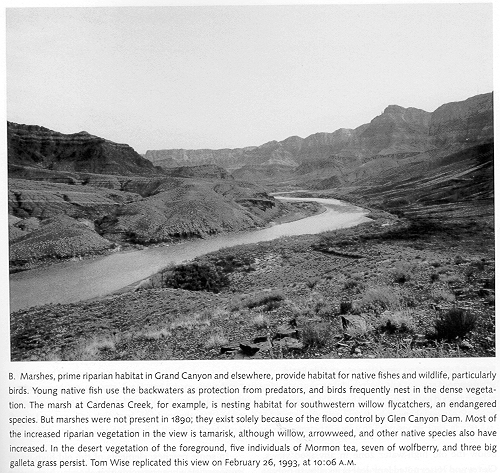

"Visitors to the bottom of Grand Canyon frequently are delighted with large
populations of birds and other wildlife. The abundance of wildlife is due partly to the
presence of marshes, which occur mostly in wide sections of canyon where large eddies have
formed. Wildlife tends to be concentrated in these wide reaches. The seemingly
impenetrable vegetation of marshes forms a protective cover for many species of nesting
birds and other animals, some of which are not native to Grand Canyon (e.g. Black-Chinned
Hummingbirds). Native species, such as beaver; have prospered in the dam-controlled river,
largely because the new high-water zone provides more food."
"Before Glen Canyon Dam, marshes were well developed in spring-fed areas above
the high-water zone. These marshes are still present and look very much like they did in
1890. However, other marshes have since developed. Marshes that are now present below
the old high-water zone owe their existence entirely to Glen Canyon Dam. Before
regulation, flow in the Colorado River varied too much to allow the establishment of
marshes with perennial vegetation. Floods once tore through areas that now support
marshes, scouring sediment and ripping out any vegetation that might have become
established in the short interval between floods. Moreover, these areas were inudated for
long periods during late spring and early summer, when many marsh plants would
germinate."

"Marshes were not present in 1890. Marshes require hydrologic
stability: They develop where changes in river stages are minimal and flow velocities are
low. They exist solely because of the flood control by Glen Canyon Dam."
"Marshes, prime riparian habitat in Grand Canyon and elsewhere, provide habitat for
native fishes and wildlife, particularly birds. Young native fish use the backwaters as
protection from predators and birds frequently nest in the dense vegetation. The marsh at
Cardenas Creek, for example, is nesting habitat for southwestern willow flycatchers, an
endangered species."

A small marsh just downstream of Glen Canyon Dam is known to have a rare population of
Northern Leopard Frogs. Scientists from all over the country have come to the Horseshoe
Bend Marsh to examine these frogs. The frogs are not yet on the endangerd species list but
herpetolgists worldwide are concerned at the decline of leopard frogs (Lake Powell
Chronicle, 1997).

"Occasionally, marshes need scouring flows to open the waterways, which become
clogged with sediment. In the era of flow regulation, this scouring occurs during the
highest of the daily fluctuating flows."
References:
Robert H. Webb, "Grand Canyon - A Century of Change"(Tucson: The
University of Arizona Press, 1996).
Tracy Homet, "Leopard Frog a local beauty not always seen", "(Page:
The Lake Powell Chronicle",1997).